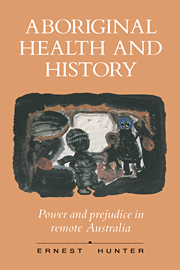4 - Mortality in a Time of Change
Published online by Cambridge University Press: 18 October 2009
Summary
Searching through archives may, like a night-backed window, reveal more about the observer than what lies in the darkness beyond. Compiled by Europeans, the early records of the Kimberley focused on their lives — their births, marriages, deaths and deceits. Obscured are the Aborigines who had lived and died unrecorded in the region for millennia. After a century of accommodation and adjustment, these Aborigines are now required to face new dangers accompanying new levels of change. This chapter presents material on Kimberley Aboriginal mortality over 30 years (1957–1986). The period was selected as it covers 15 years before and after the extension of full citizenship rights to Aborigines in the Kimberley.
THE POPULATION
There are two recurring problem areas in the analysis of Aboriginal mortality data: the definition of the denominator (the Aboriginal population) and of the numerator (deaths). Historically, the changing construction of who constituted an Aborigine, and different approaches to collecting data, have led to widely varying population estimates. Consequently, the 1971 census, the first to count Aborigines, reported an increase of 30,000 over national estimates for 1966, mainly due to increases in New South Wales and Queensland. In 1976, following the Referendum, a further 45,000 were added, with the largest proportional growth being in Victoria, Tasmania and the Australian Capital Territory. However, the 1981 census generated a national total 1000 less than that for 1976, with the only areas demonstrating an increase being Western Australia, the Northern Territory and Queensland.
- Type
- Chapter
- Information
- Aboriginal Health and HistoryPower and Prejudice in Remote Australia, pp. 76 - 89Publisher: Cambridge University PressPrint publication year: 1993



